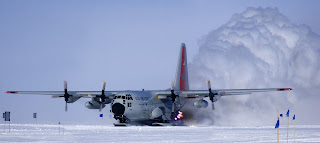
One day I was wondering what ever happen to the house I built in Greenland. I thought with the annual snow fall of 4 feet a year, I built that house in 1990, that's 16 years ago. Then that would mean that that house would be 54 feet under the snow surface, subtracting the 10 feet it was above the surface. So just out of curiosity I decided to google the house site and see if I would fine anything on it.
I was profoundly surprised to find it was not only not buried in snow, but above the surface and thriving in supporting a growing community of scientific researchers. When I found your web site I was ecstatic to find such an awesome gallery of photos of the big house, as it has been called. I am glad that the summer camp I had thought I built has been winter over also is great news. The winter aurora shots are awesome too.
Well after seeing all the excitement that is going on at the Big House I thought you might like to hear from the guy who designed and built the Big House. I was working for a company in Brattleboro, Vermont, Winter Panel Co. I was the original designer for the company having been there 7 years. The company produces foam core panel homes with and without timber frames. I had just finished a job in Concord, Mass. With This Old House Show, I was in the back ground working on the job, in the show.
 I have been a hiker and skier in the mountains of New England all my life, so the idea of going to Greenland excited me greatly. I over saw all prefabricated parts at the factory in Brattleboro, Vt. I personally delivered the tools, doors and windows, to Schenectady, N.Y. Hopped on a C130 with the 109 Air National Guard and in 6 hours was in Sondrestrom, Greenland. Waited a few days while the guys digging World War II planes out of snow to get to work, Then it was our turn to fly up. The US site was snowed in with a herbi, blizzard, so we flew to the European site, where they loaded up sleds with our gear, with me sitting by myself on the back, and went 40 kilometers to the US site. What a ride that was. Talk about getting away from it all. Well we had a great two weeks building the Big House, and the rest of the story is history.
I have been a hiker and skier in the mountains of New England all my life, so the idea of going to Greenland excited me greatly. I over saw all prefabricated parts at the factory in Brattleboro, Vt. I personally delivered the tools, doors and windows, to Schenectady, N.Y. Hopped on a C130 with the 109 Air National Guard and in 6 hours was in Sondrestrom, Greenland. Waited a few days while the guys digging World War II planes out of snow to get to work, Then it was our turn to fly up. The US site was snowed in with a herbi, blizzard, so we flew to the European site, where they loaded up sleds with our gear, with me sitting by myself on the back, and went 40 kilometers to the US site. What a ride that was. Talk about getting away from it all. Well we had a great two weeks building the Big House, and the rest of the story is history.A final note, the next year,1991, I got to design and build 4 summer camp buildings at the South Pole. You can see them there, they are the first buildings to be built above the surface on metal frames. They also are wintered over in.
Dan Scott Designs
Architectual CADD Design
1548 Back Westminster Road
Westminster, Vermont 05158
(802) 463-1961 phone / Fax














































